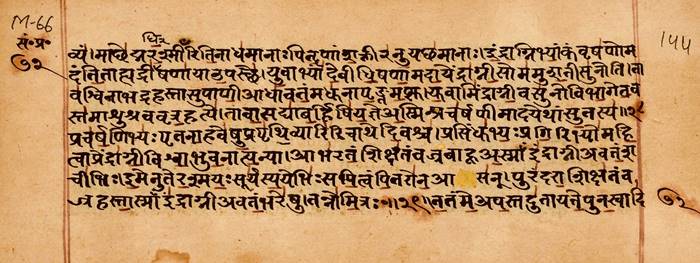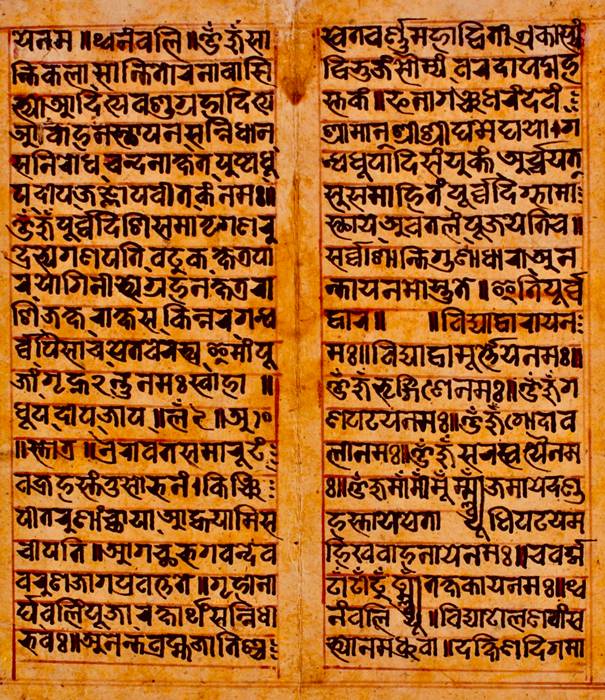The Sanskrit language is not only the oldest among the languages found in historic India but also is one of the most famous. The pride of Indians is not just Sanskrit as a language, they also consider it as a cultural heritage that gives uniqueness and richness to the customs and traditions of their land.
Having its roots in the history of 3500 years, this language dominates the list of the oldest languages at the global level. Sanskrit is the earliest language in the world, it is believed to be the cradle of all literature. It is part of the Indo-European family of languages, one of the oldest branches of this family. Sanskrit is a sister language to the ancient classical languages of Europe, such as Greek and Latin. Modern north Indian languages are derived from it, and even south Indian languages are full of Sanskrit words.
“Sanskrit language, which is a standard to be judged by those qualified to judge, is one of the greatest, perfect, prominent and wonderfully complete literary instrument invented by the human mind.” :: -Sri Aurobindo
All the languages of India and also some of the immediately neighboring languages such as Singhalese, Burmese, and Malaysian are of the view that Sanskrit is the main source that they are borrowing from to develop their vocabulary to suit the civilization of theirs. The knowledge that Sanskrit was a sister language of the West made it necessary for the Europeans to learn it so that they could understand the origin of their languages and the early stages of their development.
Hence, Europeans started to study Sanskrit as their language. In the West, the level of awareness and an increasing tendency towards the study of Sanskrit is higher than in India. This is because the Sanskrit is viewed as the oldest member of the Indo-European family all around the world.

SANSKRIT language, more popularly known as ‘God’s language’ is honored on Indian soil. Before the Arabs invaded the Indian subcontinent this language was a lingua franca. One word may have the feature of being described in a hundred different words of Sanskrit.
Sanskrit language is so unique, rich in its grammatical structure and vocabulary, that it makes it both challenging and exciting to learn!
Indians believe that Sanskrit language originated from God’s era and it can generate sacred vibrations in the world environment around us. Sanskrit’s sacred status is matched by its orderly systematic approach which is also known as the most scientific language!
It is interesting to note that since the beginning, the sounds of each of the 36 consonants and 16 vowels of Sanskrit are fixed and precise. They remained unchanged, they were not manipulated, they were not improved, they were not changed. The words of Sanskrit always had a unique pronunciation and are pronounced the same as today. There was no ‘sound shift,’ no change in the vowel system, and no new word-formation grammar rule was ever created in Sanskrit. The reason is the complete perfection by its nature and formation in itself.
Book to Read:
Sri Aurobindo and Sanskrit
₹75.00
This research work reveals one of the least known aspects of Sri Aurobindo: his knowledge of Sanskrit language and literature, and the insights he has given into its origins. The book also contains some extracts from Sri Aurobindo’s original contributions in Sanskrit.
The morphology of word formation is unique because it’s of its kind where a word is constructed from the smallest seed root (dhatu) in a precise and unchanged grammatical order ever since the beginning. Since its basic words are the root words, it can have any word desired by the usage of prefix and suffix system as is shown in the Ashtadhyayi of Panini. Moreover, all the 90 forms of a verb and twenty-one forms of a noun or a pronoun can be created that can be used in any situation.
No other language in the world has ever experienced a change in the form of the Sanskrit grammar science like it did. The Vedic Sanskrit language, which was already perfect from millennia before, existed even before the infancy of the earliest world languages like Greek, Hebrew, and Latin etc.
It is impossible for a person who does not know the language to pronounce the words exactly in the same way as the speaker does. Consequently, these words are transmitted by word of mouth to another region of the land where these words have to be used by people who have no links with the original speakers of the words and lastly, the words may have an unrecognizable appearance and form.
Similar to the Sanskrit word matri, where the long ‘a’ is pronounced, the soft ‘t’ followed, went to mater in Greek and to mother in English. The last two words are called ‘matri’ in Sanskrit language. In all the languages of the world, mix of Sanskrit words is found and this itself proves that Sanskrit was the mother language of the world.

The above statements are enough to prove that Sanskrit is the source of all languages and not any derivation from any language. Therefore, Sanskrit is the divine motherly language of the whole world.
Whichever part of the country you come from, you will find Sanskrit in your life and use it almost as a tool to bring the country together. There are many masterpieces in the Sanskrit language. Our Indianness is intrinsically tied to that language. Future generations would be studying them and so, Sanskrit learning becomes necessary.The Nobel Laureate physicist, Dr. C. V. Raman, said that “Sanskrit is flowing through our veins. It is Sanskrit that forges the unity of the nation.”
“If I was asked what is the greatest treasure which India has and what is her greatest heritage, I would simply answer that this is the Sanskrit language and literature and all that it comprises. This is a truly magnificent inheritance, and so long as it is preserved and continues to influence the life of my people, so long will the basic genius of India continue.”
— — Jawaharlal Nehru (Taken from ‘The Discovery of India’)
Benefits of understanding Sanskrit language:
The first point among others that make Sanskrit the best language is its script. The Sanskrit language is written in the Devanagari script. Which is better for writing and is easy to pronounce perfectly once learned.
The research carried out by the scientists from the National Brain Research Centre (NBRC) has identified that reading the Devanagri script requires the engagement of more areas of the human brain than Roman Scripts (used by the English language). That means Sanskrit language brings good exercise to the human brain.
The Devanagari is according to them written in a left-to-right linear order of the consonants and the vowel signs are placed above, below or on either side of the consonants. Thus, vowel will come before the consonant in writing particular words whereas it will be after consonant in speaking which makes it a unique script. The results show the participation of the two hemispheres of the brain, left and right, for reading a phrase in Devanagari.
Through knowing Sanskrit language you can see the whole angle of Vedas, Geeta, Upanishads, Ramayana, Mahabharata, Arthashashtra and many other books, which are even now regarded as the best by a lot of people in our society. Although they are translated into different languages the original works are always a barrier between the readers and the books.
Along with the major subjects like the Ayurvedic Medicine, Yoga, Indian philosophy, Vedic Mathematics and Astrology, one must know partial Sanskrit. Knowledge of Sanskrit helps one in learning other languages : Knowledge of Sanskrit language helps one in learning other languages :
Sanskrit is not only English but it is easy to learn any Indian language once we learn Sanskrit due to the fact that grammar, pronunciation and script are similar to Sanskrit
Sanskrit Language as Computer Language:
Among the first scientists to suggest Sanskrit as one of the best languages for use in computers was Rick Briggs (in 1985). In his paper Knowledge Representation in Sanskrit and Artificial Intelligence, he highlighted why Sanskrit had the potential for use in computers. He says that Sanskrit is the natural language in which the computer transmitting a message can do so in the shortest form of words.
We can state that Sanskrit is one of the biggest treasures left to us by our ancestors. It is usually believed that Sanskrit is hard to learn, but Sanskrit is closely associated with our mother tongue that we can learn easily. In the present day, the number of people who speak Sanskrit language is decreasing. It is the challenge for us whether we would be able to revive Sanskrit and make it the spoken language again or not.
Israel is a superb example: they were at the head of a movement to revive their cultural Hebrew language, which was also considered as a dead language once, today they made it an official one which led them to grow from their roots.
INDO-EUROPEAN SANSKRIT CONNECTION
Heinrich Roth was the first German who learned this language, went to the country of India, and became amazed by the mystery of Indian culture. He had realized that Sanskrit too is an integral part of our sacred beliefs as well as the most well-planned language.
Friedrich Schlegel and August Schlegel were Indologists who were experts in the field of the complexities of Sanskrit. They were so impressed by the beauty of this language that they made Indology a standard subject in the prestigious University. They published Latin Bhagavad Gita in 1820s and later it became the first Sanskrit language book ever printed there in Europe.

INDO- GERMAN SANSKRIT CONNECTION
Is it the passion and attraction towards the Indian culture that draws Germans to Sanskrit? Or was it a connection, or was it a trace of some unknown link?
YES! Both of these languages, which are Indo-European, not only have the same structure of vocabulary but also of grammar and word-formation. In both languages, adjectives are applied according to their gender, number and cases. The 7 most frequently occurring Sanskrit cases are very closely related to the 4 cases of German.
The Upasargas conception in Sanskrit also appears in German with prefixes such as emp, ent, be and so on that are combined with certain verbs to form new ones.
These are some of the most remarkable similarities among many German and Sanskrit words –
• Gemischung in German and मिश्रणं in Sanskrit mean mixtures.
• Mann German and मनुः Sanskrit are male in origin.
• Nase in German and नसा in Sanskrit is the nose.
• In Sanskrit a mother is called माता while in German she is called Mutter.
• Father is called ‘Pita’ in Sanskrit and ‘Vater’ in German.
These words are as good evidence as we need that there is a link between the two languages. Those cultural and vocabulary matching is the more reason that it has led the Germans to explore the wonders of Sanskrit.
World Sanskrit Day
Also known as Vishva-Samskrita-Dinam (Sanskrit: विश्वसंस्कृतदिनम्), is an annual event focused around the ancient Indian language Sanskrit that incorporates lectures about the language and is aimed to promote its revival and maintenance. It is celebrated on Shraavana Poornima, that is the full moon day of the Shraavana month in the Hindu calendar. This generally corresponds with the month of August in the Gregorian calendar. Info from Wiki




